ISSN ONLINE(2319-8753)PRINT(2347-6710)
ISSN ONLINE(2319-8753)PRINT(2347-6710)
Rajasekharachari K, G.Balasundaram, Kumar K
|
| Related article at Pubmed, Scholar Google |
Visit for more related articles at International Journal of Innovative Research in Science, Engineering and Technology
For the smart grid arrangement a battery energy storage system is important equipment of renewable energy resources. In this paper we will have a discussion on active power control in a battery storage system with a topology of cascaded multi level inverter with pulse width modulation switching technique. Multilevel inverters have been attracting in favor of academia as well as industry in the recent decade for high-power and medium-voltage energy control. A battery energy storage system (BESS), combining battery packs with a power converter and control, should be installed in the vicinity of an intermittent energy source. Here we can control the active power as individually in a converter cell battery arrangement unit, by this we can have a advantage of charging and discharging of a battery units at different power levels. The charging/discharging of the battery in a dc form can be shown in this paper. From the controlling of active power as in a individual converter cells we will get maximum utilization of battery power to the load as required. If we will get a less harmonic content in the output voltage definitely we can improve the utilization part, so this can be obtain by getting the multiple level of voltage as approximately sinusoidal with maximum reduction of harmonics. The simulation results for this proposed system have been shown in this and also multiple levels of voltages in output can be shown in this paper.
Keywords |
| renewable energy resources, Real-power control, battery energy storage systems, multilevel cascade converters, Active-power control, multi level inverter, battery storage. |
INTRODUCTION |
| The renewable energy resources are intermittent in nature under the influence of meteorological fluctuations, which may produce a bad effect on grid voltage and frequency stabilization. Battery energy storage systems are indispensable to promote grid connections of massive renewable energy resources, thus making battery energy storage systems crucial in the smart grid. Table I shows some major battery energy storage systems that have already been installed in the world. The details for each system include the location, capacity, battery, application, and year of installation. The BEWAG AG’s 17- MW 14-MWh system in Berlin, Germany, is the world’s first large commercial battery energy storage system. Today, the 40-MW 14-MWh system in Golden Valley, Alaska, USA, and the 8-MW 58-MWh system in Hitachi Factory, Japan are the world’s largest battery energy storage systems in terms of power and energy, respectively Traditional battery energy storage systems are based on combination of a multi pulse (12-, 18-, 24-pulse, and so on) converter with a complicated zigzag transformer. The line-frequency transformer is expensive, bulky, lessee, and prone to failure. The lead-acid battery representing an established and mature technology has been preferable in the traditional systems. However, it has some serious drawbacks, including slow charging time, low energy density, end-of-life environmental concern, and short cycle life. Modern battery energy storage systems are based on the combination of a multilevel converter such as diode clamped and cascade H-bridge topologies with an advanced battery technology, such as lithium (Li)-ion, sodium sulphur (NaS), nickel metal hydride (NiMH), and so on. ABB and Saft have recently developed a 600-kW, 200-kWh battery energy storage system based on a neutral-point clamped (NPC) converter and a Li-ion battery for the 11-kV distribution system of EDF Energy Networks, U.K.The multilevel cascade converter may be one of the most suitable multilevel topologies for the modern battery energy storage systems. A battery energy storage system based on the combination of a multilevel cascade PWM converter with multiple NiMH battery units and addressed two key considerations for practical use .The state-ofcharge (SOC) balancing of the multiple battery units for effective utilization of battery energy, while presented fault tolerance of the cascaded converter for enhancing reliability and availability. There are, however, several other issues to be addressed as will be briefly explained in the following section. One of them is the real-power control of individual converter cells. Manufacturing tolerances and operating conditions may cause small differences among multiple battery units in the multilevel cascade converter. These differences tend to be magnified over time, thus requiring individual power-handling capability to the battery units. This capability may also be required when one or more of the battery units in the cascade converter are replaced by new ones. For the maximum utilization of battery energy, it would then be necessary to operate one or more battery units at reduced or increased power levels. The active-power control of individual converter cells for a battery energy storage system based on a multilevel cascade PWM converter. This control based on neutral shift1 enables the multiple battery units to operate at different power levels while producing a three-phase balanced line-to-line voltage. Experimental results obtained from a 200-V, 10 kW, 3.6-kWh laboratory system verify the effectiveness of the control method. |
II. THE BATTERY ENERGY STORAGE SYSTEM |
| An energy storage system is indispensable for compensation of the active-power fluctuations, which is often referred to as “power leveling.” For example, if a wind turbine generator produces a larger power than an average power over a period of time, say several seconds to 30 min, the energy storage system stores the excess power from the grid. On the other hand, if the generator produces a smaller power, it releases the shortage of power back to the grid. The energy storage system brings a significant enhancement in power quality, stability, and reliability to the grid. Batteries are dc sources, power conversion is required to interface these batteries to the ac system. The most convenient way of conversion is to have a four-quadrant converter so that a bi-directional energy flow can be achieved. Voltage Source Inverters (VSI) have been traditionally used to modulate the energy flow. The voltage source inverter can be controlled to deliver real power or reactive power simultaneously and independently. Hysteresis current control with its simple design can also be used with its inherent advantages. The front-end converter regulates the real and reactive power demand of the power system under linear and nonlinear loads. The proposed scheme has the following features, |
| Has an integrated battery charging system in the main control function. |
| Provides load leveling feature. |
| Provides active filtering to eliminate the harmonics |
| Ensures unity power factor although the load is inductive |
| Has simple modular control scheme. |
| Considerations on the battery energy storage system based on a multilevel cascade PWM converter can be categorized as Follows: |
| a) Active-power control of individual converter cells: Production tolerances, uneven temperature conditions, and differences in ageing characteristics may eventually bring one or more battery units to reduced power-handling capacities. Therefore, an active-power control of individual converter cells is indispensable to enable the multiple battery units operate at different power levels. It is also advantageous when one or more of the battery units are replaced by new ones. This paper discusses the issue in detail. b) Optimization between the cascade number and the dc voltage: The cascade number2 affects communication and reliability issues while the dc voltage affects cost and life issues of battery units. Therefore, optimization between them is an important design consideration. c) Battery cost and life: The cost and life of battery units are the major hurdles in putting large-scale battery energy storage systems into practical use. Comprehensive research and development have to be achieved on cost reduction and life expansion. d) SOC-balancing of battery units: The SOC of a battery is its available capacity expressed as Percentage of its maximum available capacity. |
 |
| Due to battery-unit tolerances, unequal converter-cell losses, and so on, SOC imbalance may occur among multiple battery units. This may result in reducing the total availability of the battery units and may also cause over charge/over discharge of a particular battery unit. An SOC-balancing control is, therefore, indispensable. Tolbert et al. |
| described a switching-pattern-swapping method for SOC balancing in a multilevel cascade converter with staircase modulation for a motor drive. This paper has SOC balancing in a multilevel cascade converter with pulse width modulation for a battery energy storage system. A battery management system (BMS) plays an important part in estimating the SOC, which is often called the “fuel gauge” function. The SOC estimation may be based on measuring some convenient parameters such as voltage, current, and internal impedance, which vary with the SOC. Although it is important, the detailed explanation is beyond the scope of this paper. Tolbert et al. described a cascade converter using battery units for a motor drive. They used staircase modulation, and discussed a switching-pattern-swapping scheme for achieving SOC balancing of the battery units. However, no literature has presented experimental verification of SOC-balancing control for any cascade converter using multiple battery units. This paper focuses on SOC-balancing control for a battery energy storage system based on a cascade PWM converter. The experimental system includes no voltage-balancing control be-cause it uses nine NiMH battery units that have an almost flat charge/discharge voltage profile. Voltage-balancing control may, however, be required to a practical battery energy storage system for the purpose of mitigating the undesired harmonic currents injected into the grid. The SOCbalancing control presented in this paper is different in form and function from the voltage-balancing control. Experimental results obtained from a 200-V, 10-kW, 3.6-kWh (13-MJ) laboratory model verify the validity and effectiveness of the SOCbalancing control. Note that although the authors discuss and verify the SOC-balancing control based on a 200-V experimental system, it can be easily expanded into the 6.6-kV system having a cascade number 1 higher than that of the experimental system. The 6.6kV system is described in the following section to provide basic design concept for a practical battery Energy storage system. |
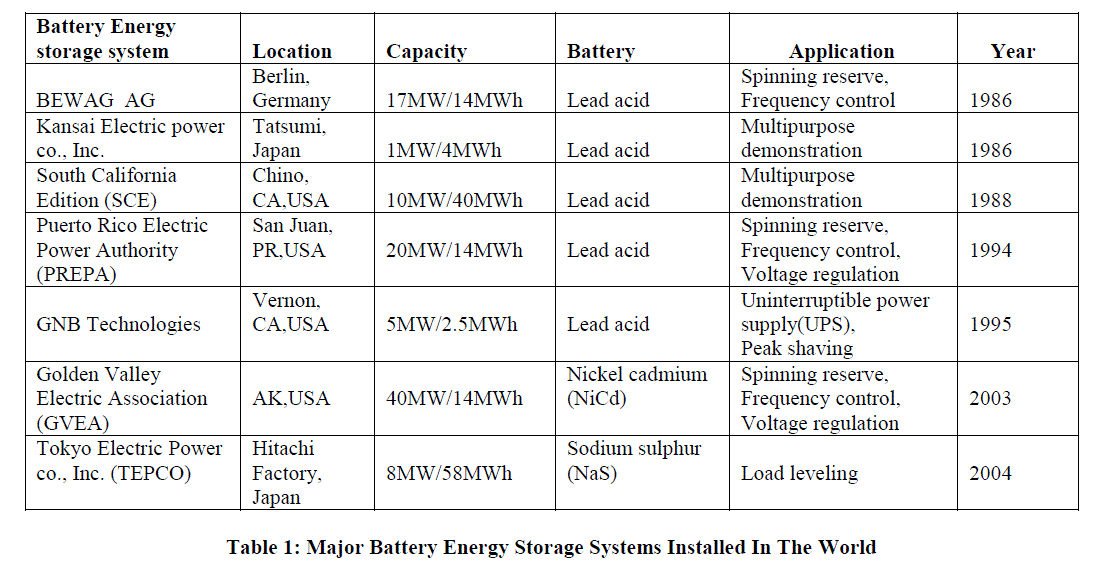 |
III. THE 200-V, 10-KW, 3.6-KWH EXPERIMENTAL BATTERY ENERGY STORAGE SYSTEM |
| In the middle of the 1990s, Lai and Peng presented a static synchronous compensator (STATCOM) for reactive-power control, which is based on cascade connection of modular H-bridge converter cells with stair-case modulation (SCM). It was followed by a battery energy storage system (BESS) with SCM for motor drives. These are characterized by eliminating the complicated multi winding phase-shifted line-frequency transformer from the power conversion systems. The multilevel inverter developed and commercialized by Robicon Corporation is referred to as a "cascade multilevel inverter," a "series-connected H-bridge multilevel inverter," or a "chain-link multilevel inverter" at present. That is, different manufactures use different names, like trade names. However, the multilevel inverter can be considered as a "modular multilevel inverter" because it is one of the modular multilevel inverters based on modular H-bridge cells. This may lead to the following confusion: when a power electronics engineer uses either "modular multilevel converter" or "cascade multilevel converter" in his/her technical paper/article or presentation,The other engineers cannot identify the circuit configuration or may have a misunderstanding about it in the worst case. The classifies the modular multilevel cascade converter (MMCC) family, the name of which merges both terms "cascade multilevel converter" and "modular multilevel converter" together. The author gives appropriate names to the four family members with focus on circuit configuration, thus resulting in identifying the individual circuit configurations. Modular multilevel cascaded converter (MMCC) family: |
| Single star bridge cells (SSBC) ïÃÆü Single delta bridge cells (SDBC) ïÃÆü Double star chopper cells (DSCC) ïÃÆü Double star bridge cells (DSBC) |
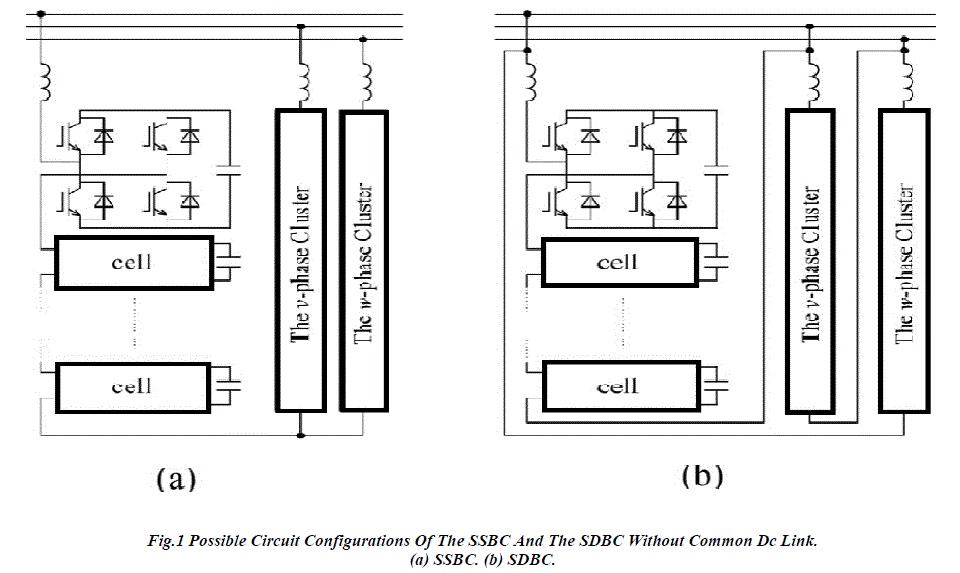 |
| Fig. 1(a) and (b) shows the following two circuit configurations, respectively: the single-star bridge cells (SSBC) and the single-delta bridge cells (SDBC). The reason for naming is that both are based on three strings of multiple H-bridge cells with either star or delta connection. This paper refers to a string of multiple H-bridge cells as a "cluster" to distinguish it from the existing terms "arm" and "leg." Fig. 2 shows the system configuration of the 200-V, 10-kW,3.6-kWh experimental battery energy storage system based on a multilevel cascade PWM converter. Table II summarizes the circuit parameters. The star-configured system has a cascade number N = 3. Each of the nine H-bridge converter cells has a 72-V 5.5-Ah nickel-metal-hybrid (NiMH) battery unit connected at its dc link. Each battery unit is equipped with a battery manage- ment system (BMS) that provides the functions of monitoring and controlling the respective battery unit to protect it against abnormal operation. In this particular range of 200-V,10-KW,3.6-KWh battery energy storage system can have the capability of control on active power which has been stored in the converter cell point arrangement. Because here we are arranging the converter cell point with battery energy storage systems with combination of cascaded multilevel H-bridge converter configuration. Control system for the battery energy storage system has been shown in fig.3. |
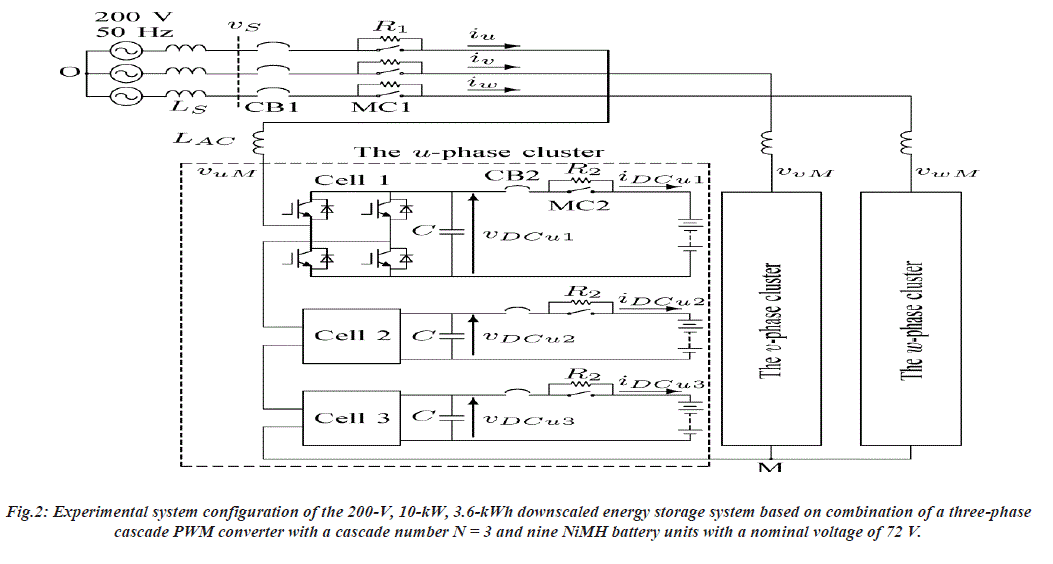 |
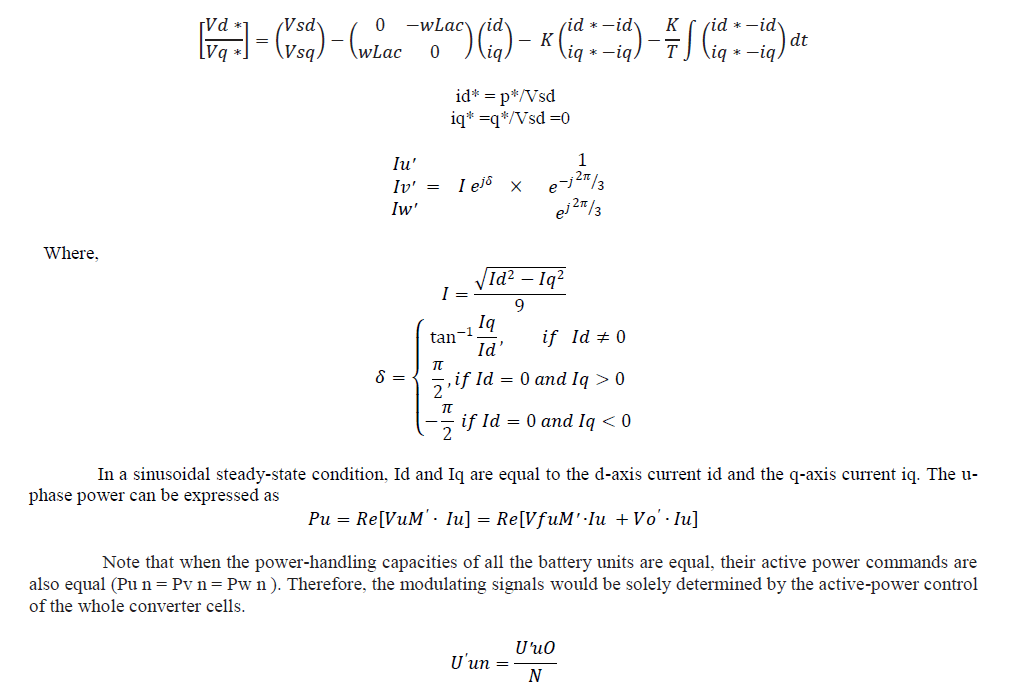 |
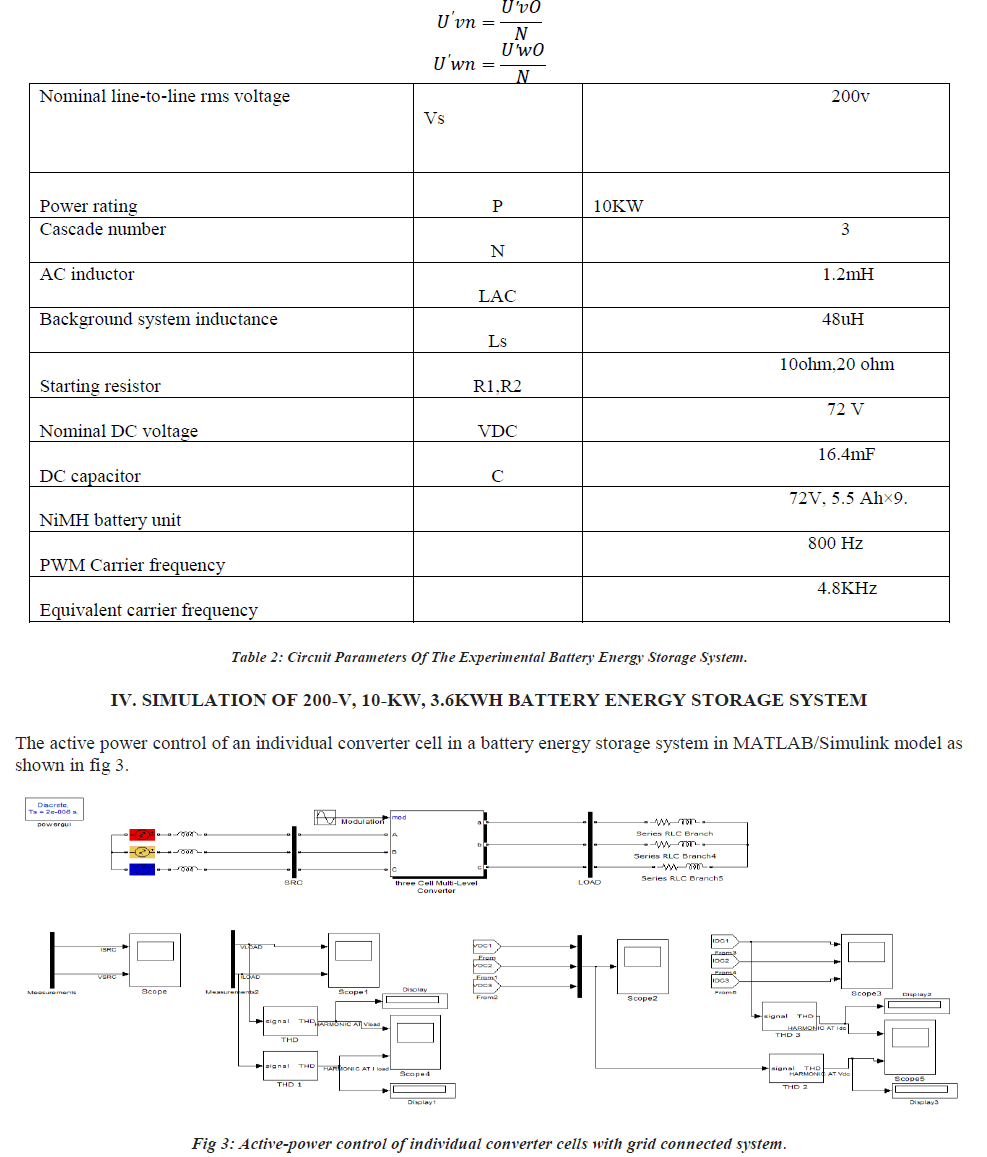 |
| Cascading of each converter cell N=3 with a Individual converter cell configuration with PWM switching model has been designed to get the active power control in each converter cell battery energy storage system designed in MATLAB-Simulink shown in fig 4. And the individual cell has been shown in fig 5. |
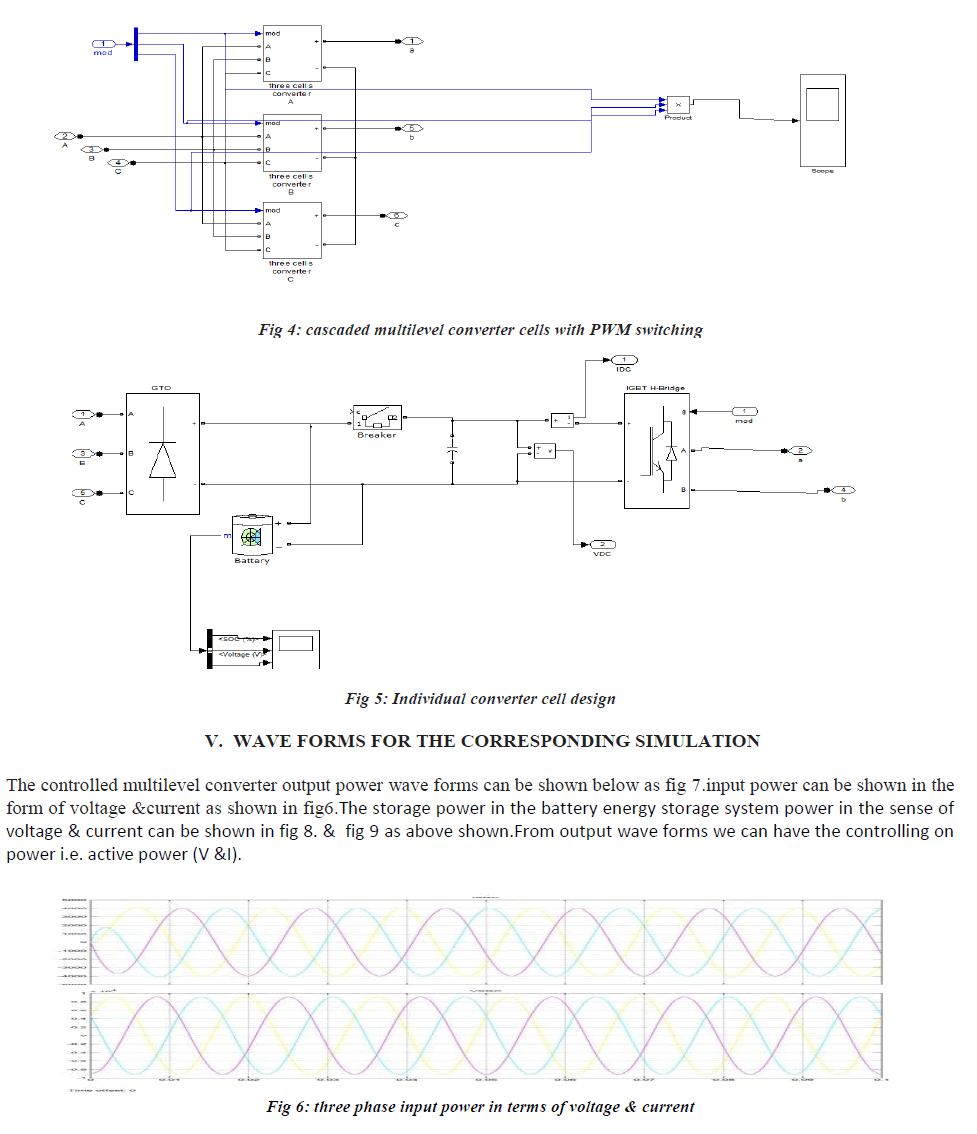 |
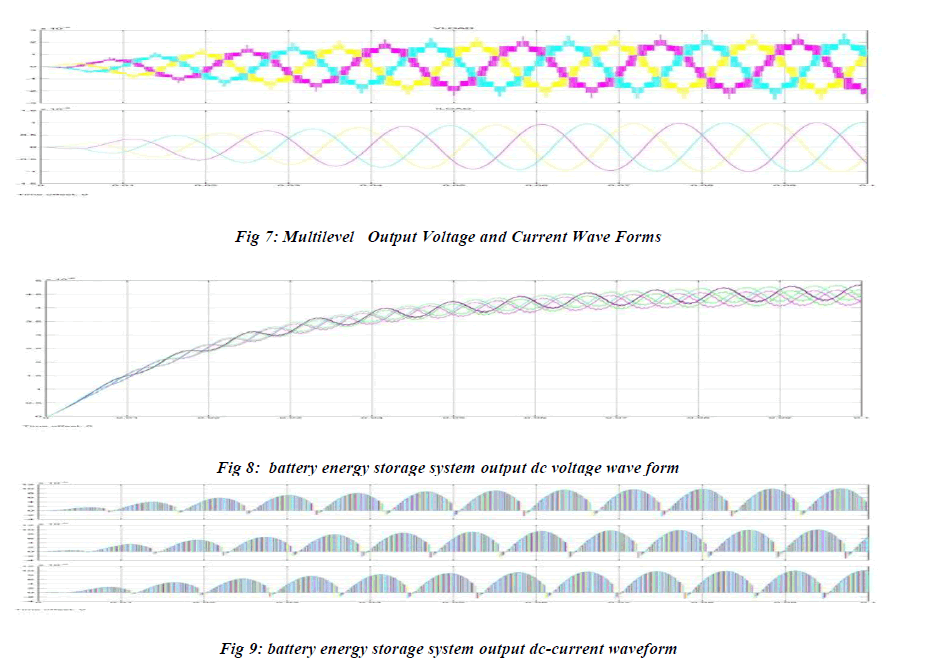 |
VI. CONCLUSION |
| This paper is mainly concentrates on battery energy storage systems to having a control on real power which is from battery energy storage system with implementation of a cascaded multilevel inverter topology. As the cost of energy storage systems decreases and their reliability increases with improved technologies, these trends are likely to accelerate and make battery storage is important part of the electricity delivery system. The presented real-power control of individual converter cells enables the multiple battery units to operate at different power levels. The harmonic content can be reduced with high effective multilevel inverter configuration, with this we will have the rapid reduction in harmonic content as results quality of output power can be improved rapidly. The simulation results for the active power control which is from battery storage system based on cascaded multilevel inverter has been shown and discussed. |
References |
|